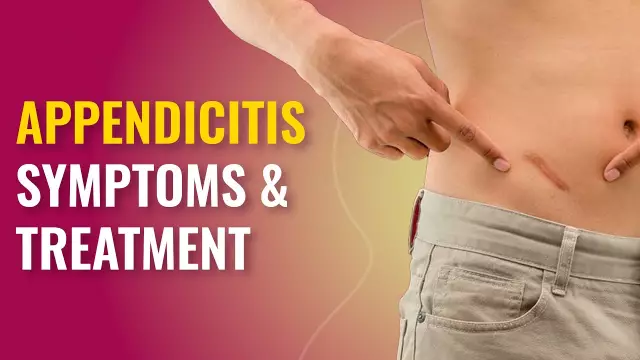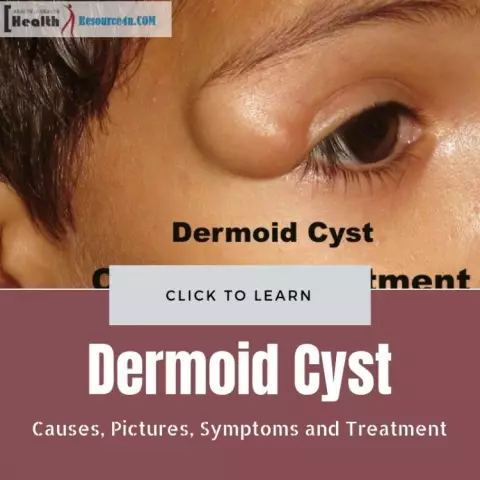- Author Rachel Wainwright [email protected].
- Public 2023-12-15 07:39.
- Last modified 2025-11-02 20:14.
Appendicitis

Appendicitis is an inflammation of the appendix called the appendix. It is a small appendage of the colon, located at the border of the small and large intestines. Due to the anatomical features, the appendix is quite often inflamed - acute appendicitis is the most common surgical disease.
This happens so often that in the thirties of the last century in Germany, a proposal was put forward to remove the appendix to children at an early age, as a preventive measure to combat appendicitis. In those years, it was believed that the appendix was an atavism, a completely useless anatomical formation, which could be completely dispensed with. However, the results of the experiment turned out to be depressing: those children who had their appendix removed at an early age subsequently developed a severe form of immunodeficiency.
Acute appendicitis, if urgent therapeutic measures are not taken, is dangerous because it leads to suppuration and rupture of the inflamed appendix, with the spread of pus and the spread of inflammation to the peritoneum - peritonitis develops, a dangerous complication that can lead to death.
Causes of appendicitis
It is believed that the main cause of appendicitis is blockage of the lumen of the appendix. This can happen due to the bending of the appendix, as well as as a result of mechanical obturation, when fecal stones or foreign bodies enter the lumen. The ingress of foreign bodies into the appendix is one of the common reasons for the development of appendicitis in children, and in adults, appendicitis is more often caused by fecal stones. Another mechanism of inflammation of the appendix is the appearance of ulcers on its mucous membrane, usually as a result of a viral infection.
Symptoms of appendicitis
The main symptom of appendicitis is sudden onset of abdominal pain. For pain syndrome in acute appendicitis, the following is characteristic:
- Initially, pain is localized in the epigastric region;
- After 6-8 hours, the pain moves to the right iliac region (Kocher-Volkovich symptom, or pain movement symptom);
- In the future, the pain takes on a diffuse character;
- The pain is constant, there may be periods of intensification and weakening of pain, but there are no painless periods;
- The pain increases with movement, so patients with acute appendicitis often move, holding the right side of the abdomen with their hands, which is one of the characteristic symptoms of appendicitis;
- A sharp pain indicates a purulent inflammation of the appendix (empyema of the appendix);
- The subsiding of pain in acute appendicitis is an unfavorable sign, since the cause of this may be the onset of a gangrenous process and the death of nerve endings.

In addition to pain, symptoms of appendicitis are loss of appetite, nausea, single vomiting, stool retention, and increased urination are possible.
Appendicitis in adults usually does not cause a sharp deterioration in the general condition, at least until the development of peritonitis. There may be a slight increase in temperature, up to subfebrile numbers (37-37.5 ° C). Appendicitis in adult patients can be simple and destructive. With a destructive course, all the symptoms are more pronounced, the pain is more significant and the general condition suffers.
Appendicitis in children is much more violent, the inflammation progresses rapidly, and peritonitis develops much faster. With appendicitis in children, severe abdominal pain can immediately be diffuse, the general symptoms are pronounced: severe nausea, repeated vomiting, fever. Appendicitis in children almost always proceeds as destructive appendicitis in adults.
Diagnosis of appendicitis
In the classical form, the disease does not cause difficulties with the diagnosis, which is made on the basis of the characteristic symptoms of appendicitis. The following tests help to clarify the diagnosis:
- Soreness in the right iliac region on palpation of the abdomen;
- Soreness in the right iliac region with light tapping (Razdolsky's symptom);
- Increased pain with a sharp withdrawal of the arm after pressing the anterior abdominal wall (Shchetkin-Blumberg impulse);
- Increased pain when the patient is lying on the left side (Sitkovsky's symptom);
- Palpation is much more painful when lying on the left side (Bartomier-Michelson symptom);
- Increased pain when raising a straightened right leg in the supine position (Obraztsov's symptom);
- Increased pain in the right iliac region when moving the hand from the upper abdomen to the right iliac region through a tight shirt (Voskresensky symptom);
- Soreness in the right iliac region with finger thrusting in the left iliac region (Rovzing's symptom).
These symptoms of appendicitis are of great diagnostic value. However, in some cases, with an abnormal position of the appendix, the clinical picture may be blurred, and some of the described signs may be negative. Symptoms that are unusual for appendicitis, such as diarrhea, may also appear.
Any signs of an acute abdomen should be alarming for an attack of appendicitis, therefore, as a rule, a clarifying diagnosis is carried out already during the operation (diagnostic laparotomy), since delay can lead to serious complications that threaten life. Due to the difficulty in making a diagnosis, abnormal forms of acute appendicitis are much more likely to cause death.
Treatment of appendicitis
Treatment consists of surgical removal of the appendicitis.
If acute appendicitis is suspected, the patient must be laid down and kept at rest until the arrival of the ambulance. Transportation to the hospital also takes place in the supine position. It is forbidden to put enemas and take laxatives, food, water, it is also undesirable to take painkillers, due to subsequent difficulties in the diagnosis.
Removal of appendicitis should be carried out as soon as possible to avoid rupture of the appendix and the development of peritonitis. In order to reduce the likelihood of infection during the removal of appendicitis, antibacterial agents are administered before the operation. Antibiotics are also prescribed in the postoperative period.
Removal of appendicitis is carried out under general anesthesia; in some cases, local anesthesia may be used in thin patients.
Currently, with a simple form of appendicitis, laparoscopic operations are preferred, which do not require an incision of the abdominal wall. In this case, the endoscopic instrument is inserted into the abdominal cavity through a small puncture in the tissues. Removal of appendicitis in this way avoids surgical trauma and shortens the recovery period significantly. The risk of developing postoperative complications when removing appendicitis by the laparoscopic method is minimal.
YouTube video related to the article:
The information is generalized and provided for informational purposes only. At the first sign of illness, see your doctor. Self-medication is hazardous to health!






